Kirchheimbolander Citizens’ Association
Revolutionary place of political associations and assemblies
The political activation triggered by the revolution of 1848/49 was initially reflected in citizens’ assemblies [Standort 56]. Just a few weeks later, a moderate-revolutionary “citizens’ association” was founded. The first steps were already taken on March 31, 1848. However, the association was not given a firm structure until July/August.
From then on, the “Kirchheimbolander “Wochenblatt” repeatedly mentioned the physician Dr. Friedrich Glaser [Standort 53] as well as the names H. Bechtelsheimer, R. Becker, L Levi jr, W. Ritterspach, G. Rupprecht, G. Seyler and J. L. N. Stöckel in the association’s news.
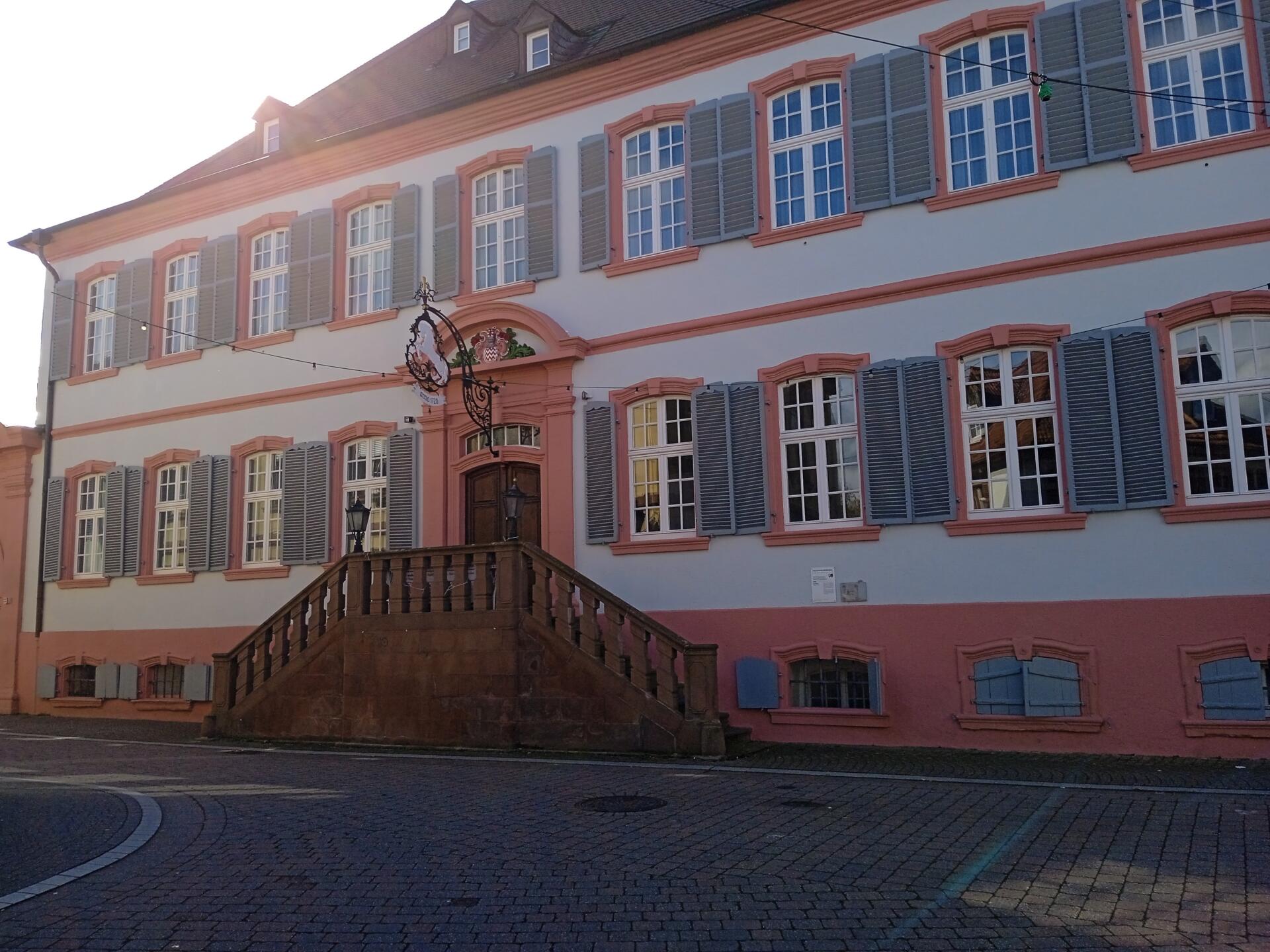
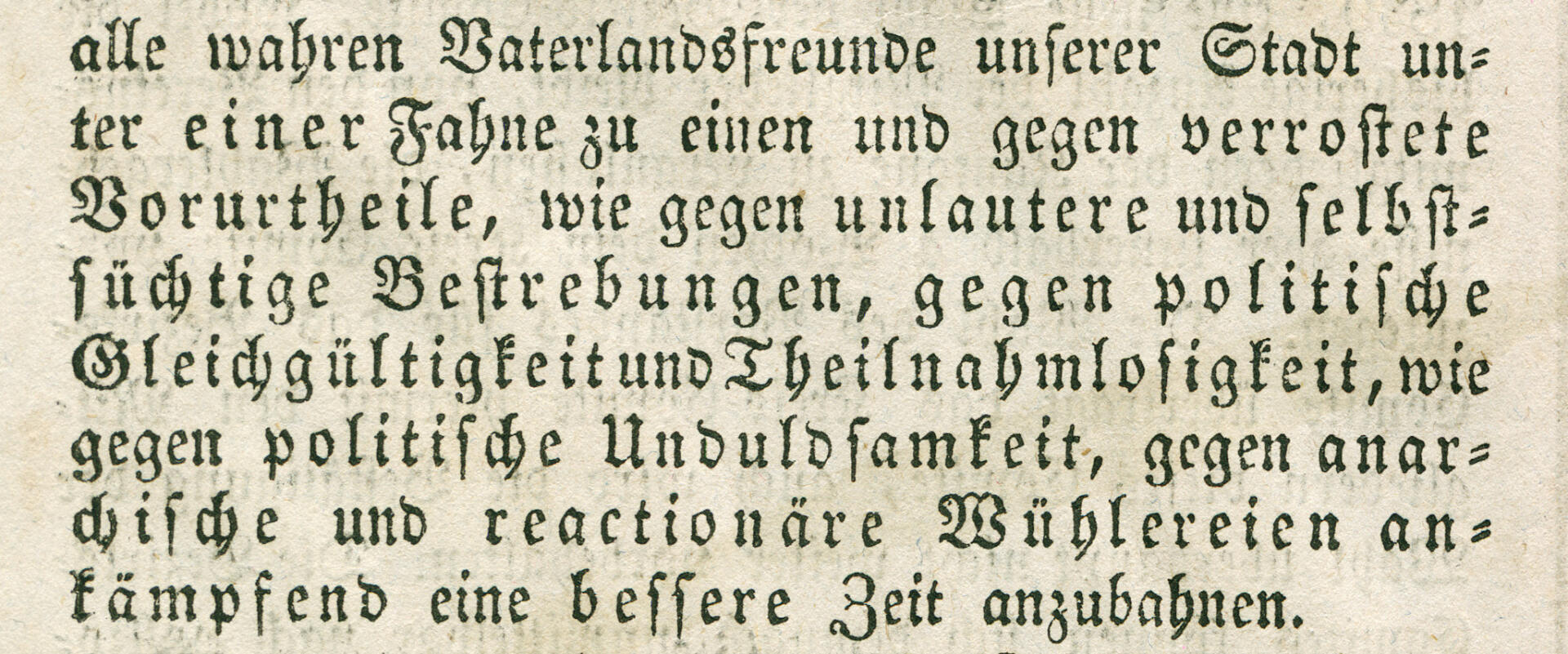
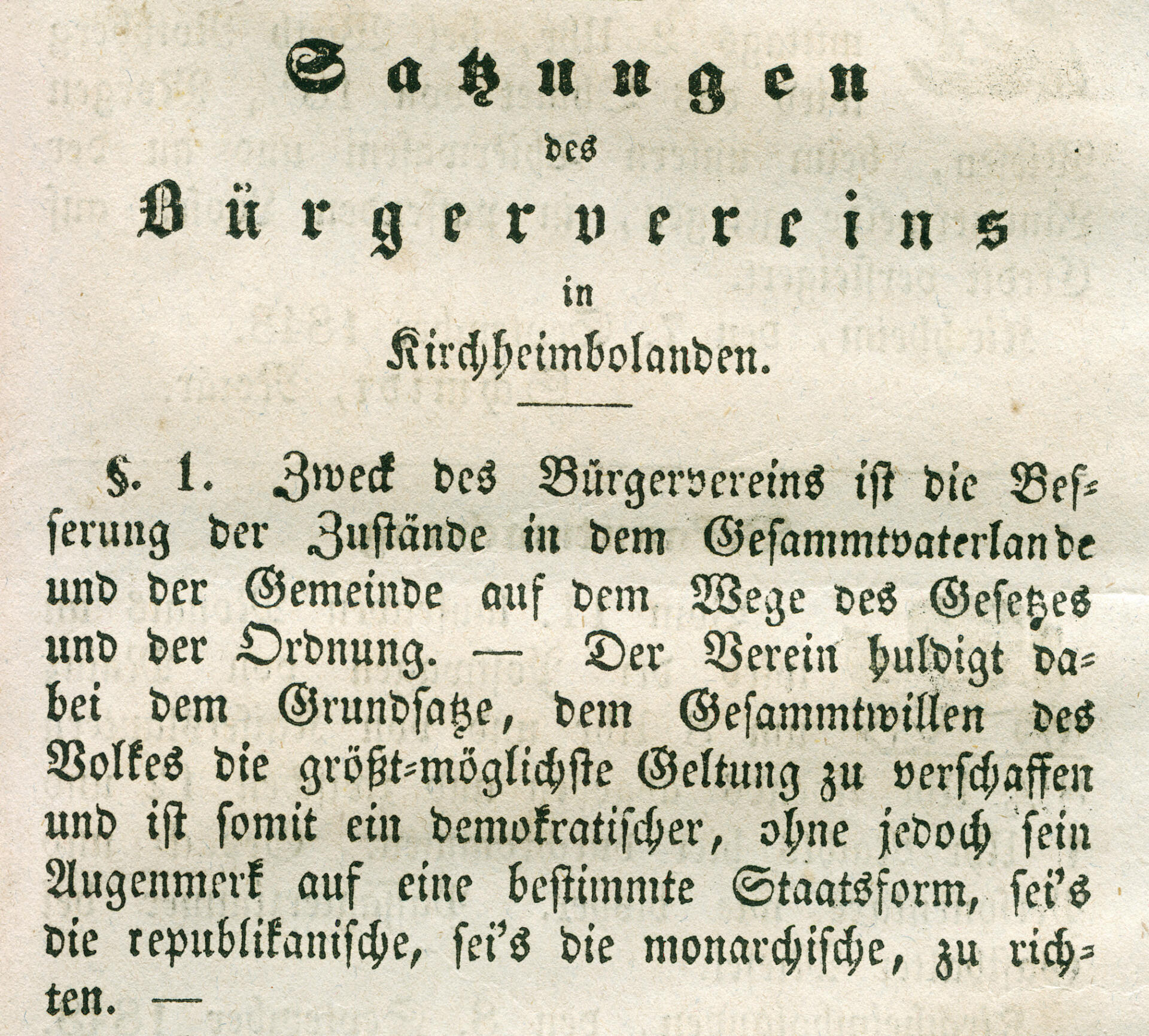
October and November 1848
In October and November 1848, the “Kirchheimbolander Wochenblatt” then issued invitations to meetings, sometimes on a weekly basis, for example Zum Wesen der Demokratie on October 26.
In December, a fundamental decision was made as to the future direction. In Kirchheimbolanden, a competitor, the “March Association”, had also become active as a local branch of the “Central March Association” founded on November 21 by members of the left-wing factions in the German National Assembly.
There were two reasons why this triggered a new dynamic in the political association system: the return to the beginning of the revolutionary events of March 1848 with the “March demands” of the time (popular sovereignty, parliamentary form of government, democratic suffrage, fundamental rights) and the direct connection of the “March Association” to parts of the Paulskirche parliament, which was to create a new dynamic.
promised a constant flow of information about the work on the constitutional project. In Kirchheimbolanden, there was an additional attraction, as there were well-known names representing the “March Association”, including the notary Karl Wilhelm Schmidt, the notary’s clerk Jakob Müller and the cantonal physician Dr. Ludwig Hitzfeld.
At the same time, the Kirchheimboland “Bürgerverein” was undergoing another upheaval: Dr. Friedrich Glaser fell seriously ill, but invited the other members of the association committee to an “extraordinary meeting” on December 21.
The new association now operated under the name “März- und Volksverein”. Of its five board members, three came from the “Märzverein” roots (Schmidt, Hitzfeld and Müller) and two from the old “Bürgerverein” (Bechtelsheimer and Rupprecht).
From the outset, however, the “March and People’s Association” had no major prospects in its activities due to general political developments in Germany. The counter-revolution was beginning to emerge, particularly in Prussia, where the King had already dissolved the Prussian National Assembly on November 9, 1848, thus ending work on a Prussian “state constitution”.
The chances of implementing the fundamental rights proclaimed by the German National Assembly in Frankfurt on 21 December 1848 and the imperial constitution adopted on 27 March 1849 therefore remained extremely slim – even by military means using volunteer troops.
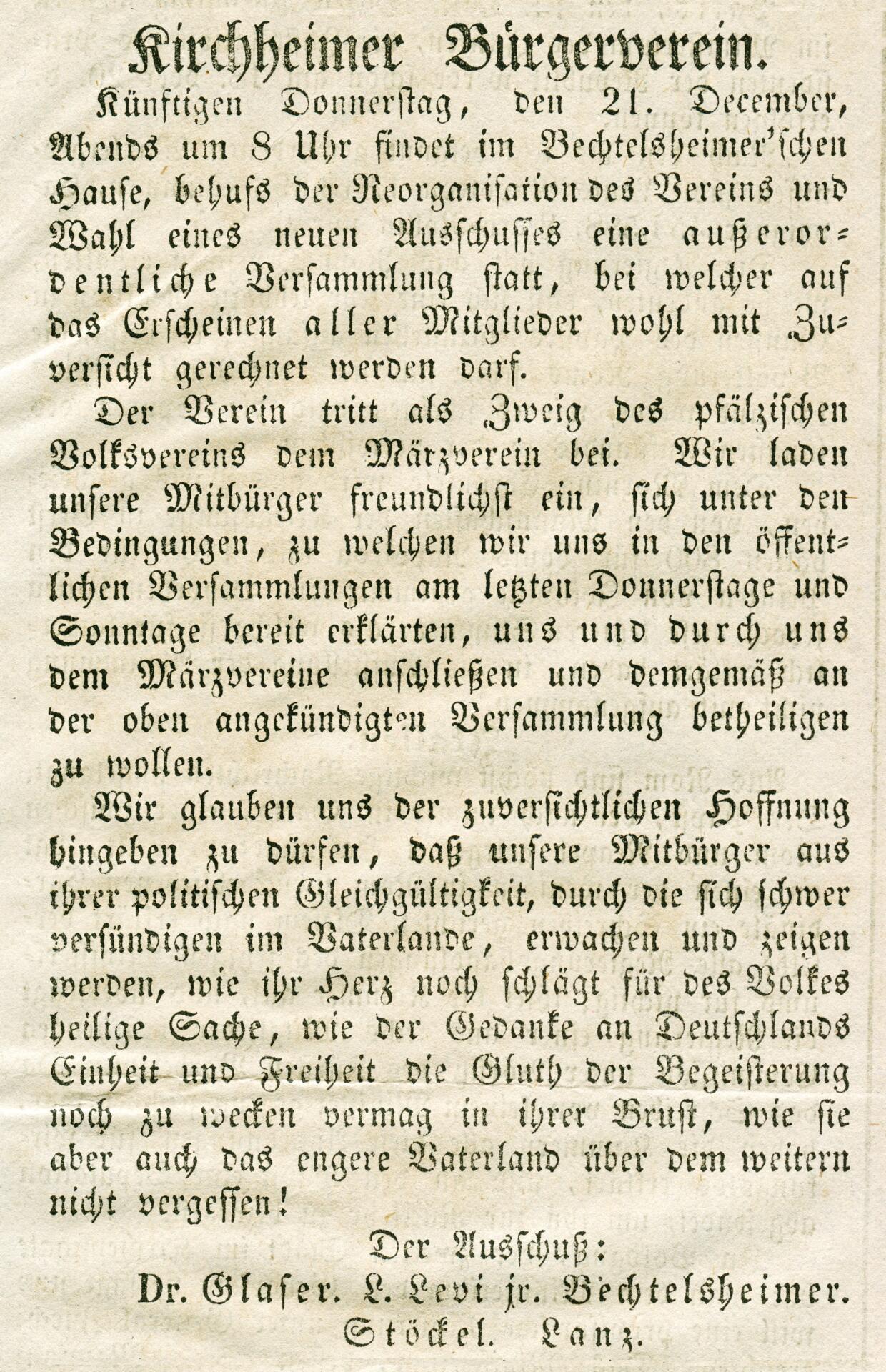
Parliament as a place of revolution
To create a constitution for Germany, for the entire empire – this was the mission with which the German National Assembly began its work in Frankfurt’s Paulskirche on May 18, 1848.
The Palatinate sent ten delegates. The constituency of Kirchheimbolanden (cantons of Kirchheimbolanden, Göllheim, Rockenhausen and Winnweiler) was represented by the notary Joseph Martin Reichard (1803-72), who was born in Gaugrehweiler and worked in Speyer.
He was a member of the National Assembly until May 30, 1849 and, within its political grouping, of the “Donnersberg” faction, named after the Frankfurt inn where the “Democrats” met. Their objective was a constitution based on universal, equal and direct suffrage.
The eventual result with its male suffrage therefore did not satisfy Reichard at all. However, it was in keeping with the “radicalism” of the “Donnersberg” faction that he advocated the forcible implementation of the constitution after its rejection by Prussia and Bavaria.
Reichard therefore also became one of the main exponents of the Palatinate Uprising, joining the National Defense Committee and the subsequent Provisional Government of the Palatinate. Although he formally held the chairmanship on both occasions, “he did not assume the dominant leadership role in the revolutionary government.”
For the Bavarian state government and judiciary, however, he was one of the main culprits. He therefore fled to Switzerland and then on to the USA. The death sentence imposed on him could therefore not be carried out.
The revolution brought a similar biographical break for Reichard’s successor in the National Assembly, Adolf Ernst Theodor Berkmann (1802-78), a pastor in Einselthum. He took up his seat as a deputy on June 1, 1849. By this time, however, the National Assembly had already been dissolved. In order to evade Prussian troops, the remaining members of the plenary (rump parliament) moved to Stuttgart, where on June 18, 1849, the Württemberg military finally forcibly prevented the few remaining deputies from continuing their work.
Berkmann’s work as a member of parliament therefore ended after little more than two weeks. This was followed by a year in custody. He had already been charged with attending the Hambach Festival in 1832. When Berkmann was released in 1850 and the charges were dropped, he emigrated to the USA, just like Reichard.
Both political biographies thus show how the consistent commitment to “unity and freedom” in 1849 could become a personal risk.
This also applied to many others accused of being “high traitors”, including Karl Wilhelm Schmidt and Jakob Müller.
Judicial conclusions
The legal aftermath that began with the end of the revolution was extremely extensive. It also concerned the events of 1848/49 in Kirchheimbolanden.
However, many of the defendants were now abroad. Numerous sentences could therefore not be carried out, such as the death sentences imposed on Ludwig Bamberger and Franz Zitz. The court records noted for both of them: Whereabouts unknown.
Two Kirchheimboland revolutionary exponents were also no longer in the country but, like Zitz, had emigrated to the USA: Karl Wilhelm Schmidt and Jakob Müller, who were also sentenced to death.
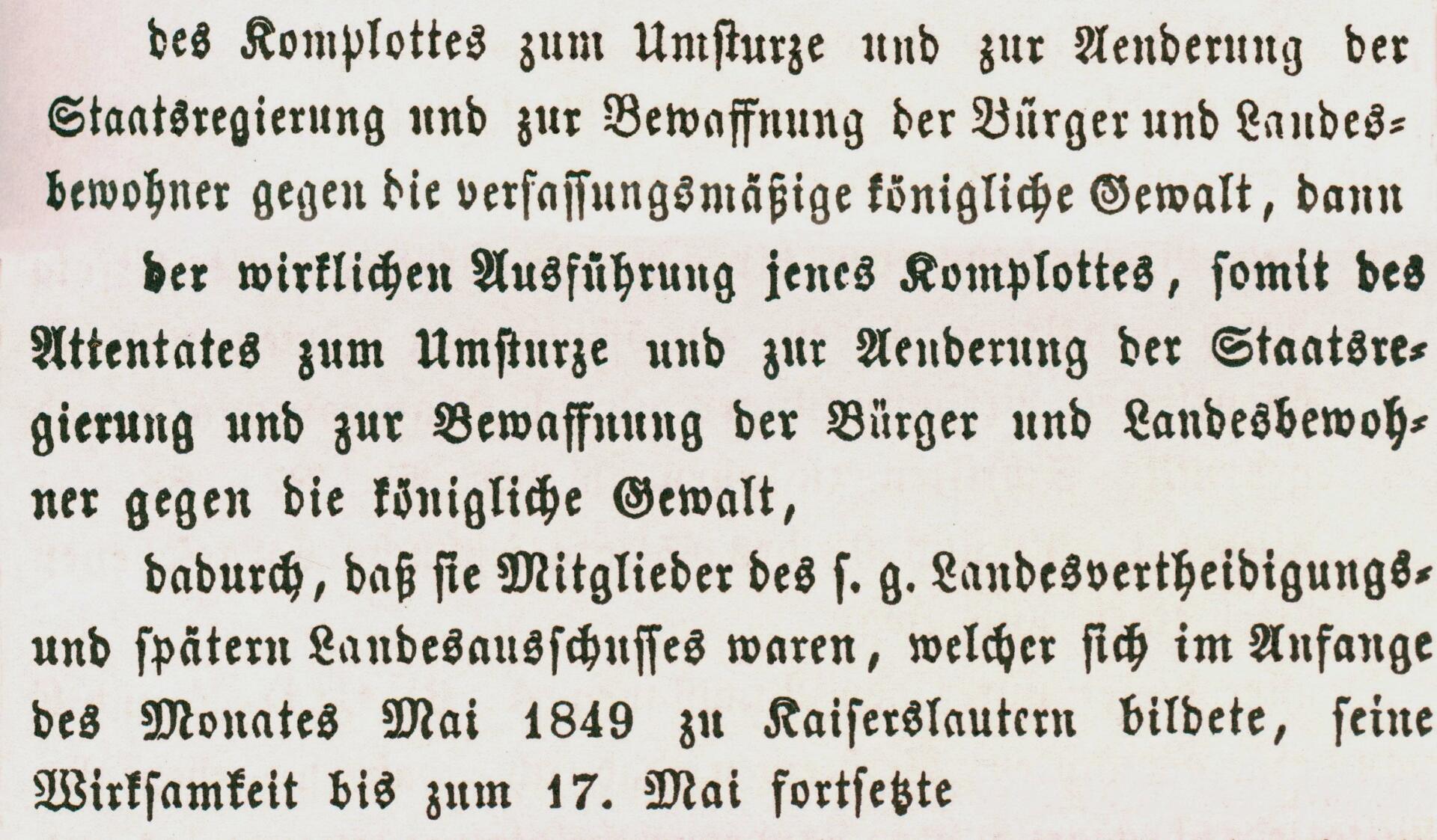
The charges against Jakob Müller (1822-1905), formerly a clerk in Karl Wilhelm Schmidt’s Kirchheimbolander notary’s office, broke down his role at the time of the Provisional Government of the Palatinate, namely that he:
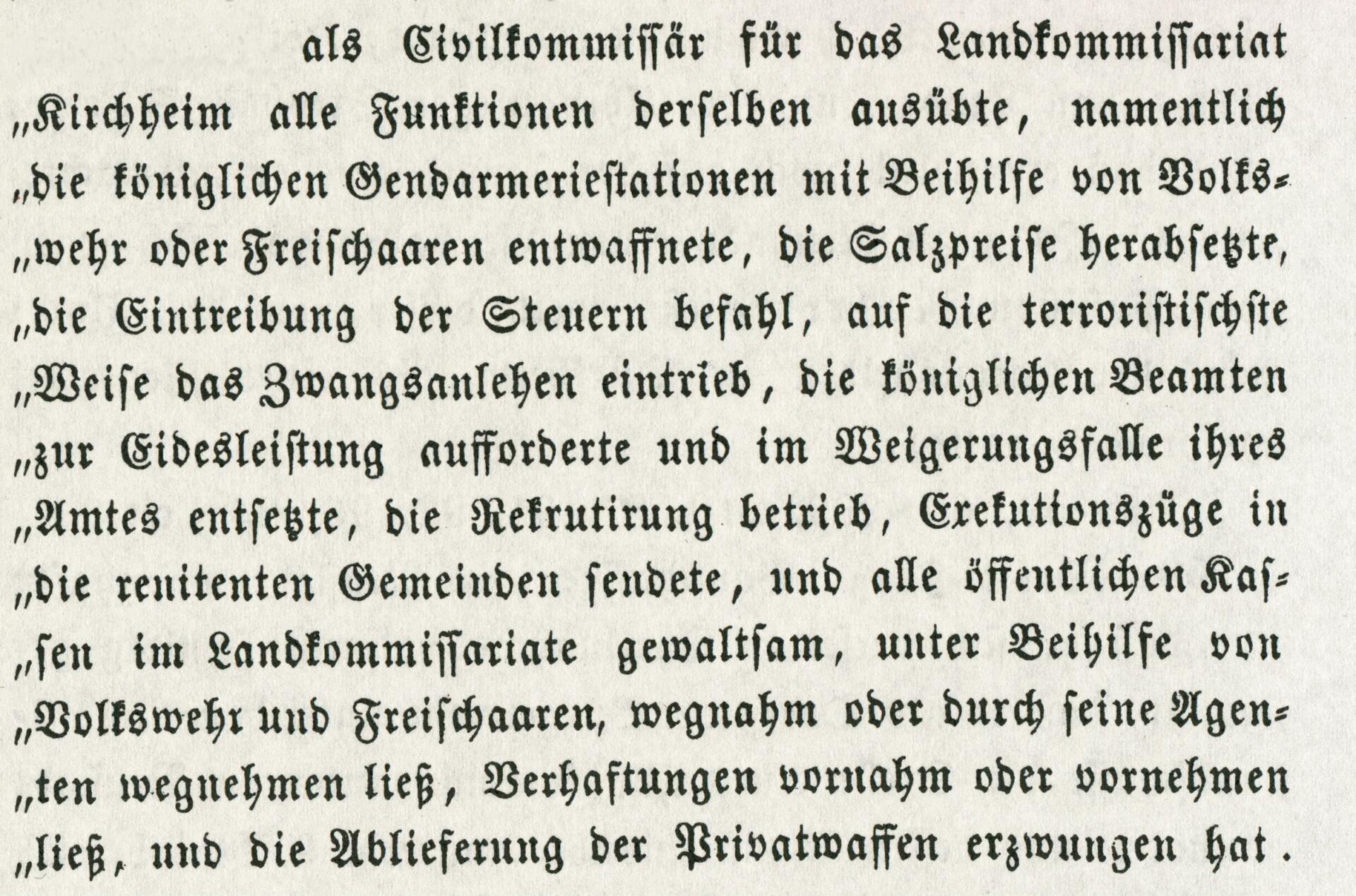
Müller was therefore charged with an extremely wide range of offenses arising from his function as civil commissioner for the Kirchheimbolanden district commissariat. However, the resulting death sentence could not be carried out either. As with Schmidt, his file noted: whereabouts unknown.
For both, emigration to the USA offered a new beginning. Müller was even able to become lieutenant governor in Ohio and in 1885 – having long since been granted amnesty in Germany – Consul General of the United States, based in Frankfurt am Main.
Numerous other Kirchheimboland defendants even got off without punishment. They were active in the Bürgerverein or Märzverein or had been involved in the local vigilantes or Freischar. Although investigations were initiated against them, the respective proceedings were dropped in December 1849. These included Heinrich Bechtelsheimer, Reinhard Becker, Dr. Ludwig Hitzfeld, Leo Levi and Georg Seyler. [Locations 57, 59]
In 1849, what had already been the case in 1832 after the Hambach Festival was repeated: the judiciary found itself in an open dilemma with the number of defendants. “Leniency” was now also the way out – also as a socially integrative factor. And death sentences – as against Bamberger and Zitz, Schmidt and Müller – could not be carried out due to circumstances.
Legally, the revolution was thus completed in the Palatinate and the old order reinstalled. There was no longer any significant “oppositional mood”. The Palatinate government president Gustav von Hohe was even able to report to Munich in 1853: ‘The political issues are taking a back seat. People were now far more interested in the construction of the railroad.
In 1854, Kirchheimbolanden also tried to get a rail connection to Alzey. This came two decades later: to Alzey in 1873 and to Marnheim the following year. This meant that Mainz, Worms and Kaiserslautern were now also accessible. Mobility and economic development were now the top priorities [Standorte 45], especially as the national idea of 1848/49 had been fulfilled in what was now the German Empire and the constitution, despite its Prussian supremacist sense, also combined parliamentary-representative and federal elements in conjunction with a contemporary catalog of basic rights.
For the Kirchheimbolander Bürgerverein, the main objectives of 1848/49 had thus been fulfilled. And last but not least: Universal, equal and direct male suffrage was institutionalized earlier than in neighbouring states, and the constitution of 1849 had not promised more than that.
“Healthy legal status”
Although the Palatinate uprising was put down in June 1849, the military solution did not automatically result in a politically viable détente. It was to be feared that the potential for conflict over “fundamental rights and the imperial constitution” would continue. However, at least the amnesty law proclaimed on December 24, 1849 with regard to the political crimes and offenses committed during the months of May and June of that year […] had the effect of calming the public. However, the Bavarian occupying troops known as the “penal Bavarians” still remained in the Palatinate, also quartered in Kirchheimbolanden. In the long term, however, this pacification based on external coercion could not be maintained.
The dilemma was therefore obvious. Friedrich Julius Stahl (1802-61), the constitutional lawyer of Prussian conservatism, therefore stated as early as 1849: The revolution is not defeated like an external enemy by the mere force of arms, but by the simultaneous establishment of a healthy state of law.
However, there could only be talk of this in 1871 – with the German Reich and its constitution now created “from above”. Until then, it was therefore important for the Bavarian government not to allow any major conflicts to arise in the Palatinate.
At the local level, this offered the opportunity for those involved in the revolutionary events of 1848/49 to remain politically active.
In Kirchheimbolanden there is therefore an astonishing continuity in the office of mayor: Reinhard Becker (mayor 1858-70), Conrad Reinheimer (in office 1858-70) and Wilhelm Ritterspach (in office 1870-99) had all three been members of the Kirchheimbolanden Citizens’ Association [Standort 60]. Becker and Ritterspach are also included in the list of individuals who were already under investigation but were then dropped as a result of the Amnesty Act.
However, it can hardly be assumed that Becker and Ritterspach, like Reinheimer as mayor, would have completely abandoned their previous political thinking.
This applies all the more to Ludwig Bamberger, who was sentenced to death in 1851 for his role in May/June 1849 as one of the commanders of the Rhine-Hessian Free Guards in Kirchheimbolanden, but was then amnestied, as he was a member of the German Reichstag from 1871-93.
So was there a healthy legal situation in the meantime?
In 1832, the Bavarian government faced the same problem after the Hambach Festival. However, the “success” was not sustainable. Here are two more examples: Johann Theobald Ritter and Carl Thieme. Both were present at the Hambach Festival, were involved in the Press Association and had also signed Knöbel’s protest. They also played a political role during the revolution: one as a member of the citizens’ association, the other as a newspaper publisher.
However, the oppositional thinking in Kirchheimbolanden leading up to 1848/49 did not only find local expression. For example, the merchant Jacob Anton Brogino (1776-1854) had been a member of the 5th, 6th, 8th and 9th Bavarian Estates Assemblies (1831-36, 39-45) and had also been involved in Hambach and the Press Association during his first term of office, as well as signing Knöbel’s “Protestation”.
The problem of the “healthy state of law” is thus, as it were, the long thread of liberal-democratic thought, which was given a conspicuous knot in 1848/49.
And today?
Today, the German Revolution of 1848/49 also appears in Kirchheimbolanden in a completely different perspective than under the conservative state “reaction” of the 1850s and especially after the establishment of the German Empire as a counter-model.
The idea now dominated – as Chancellor Otto von Bismarck had already formulated in the Prussian Chamber of Deputies in 1862 – that the great questions of the time would not be decided by speeches and majority decisions, but by blood and iron. Was this also the verdict of the imperial era on the revolution of 1848/49?
Views then became controversial during the Weimar Republic. While “parts of the left had a thoroughly positive memory of the revolution, the linking of 1918/19 and 1848/49 was more of a reason for the right to reject both revolutions equally.
The assessments after 1949 were similarly divergent: “While in the GDR the heart of the revolution was located on the streets, in the barricade battles in Berlin in March 1848, in the Heckerzug in Baden and in the violent clashes in Leipzig and Dresden in 1849, the focus of Federal Republican historiography was on the Frankfurt National Assembly and the constitutional traditions that led from the Imperial Constitution of March 28, 1849 to the Basic Law of the Federal Republic of Germany in 1949.”
And today? The volume on 30 “Pioneers of German Democracy 1780-1918” published by Federal President Frank-Walter Steinmeier in 2021 provides an essential narrative. It also includes eight “courageous men and women” in the context of 1848/49, including Mathilde Franziska Anneke, Robert Blum, Friedrich Hecker and Karl Schurz.
The question is therefore whether Friedrich Glaser, Ludwig and Mathilde Hitzfeld, Obrist Seyler, Ludwig Bamberger and Franz Zitz, as well as the Freischärler of June 14, 1849, could also be included here.
The Freischaren-Stadt-Tour Kirchheimbolanden offers answers.